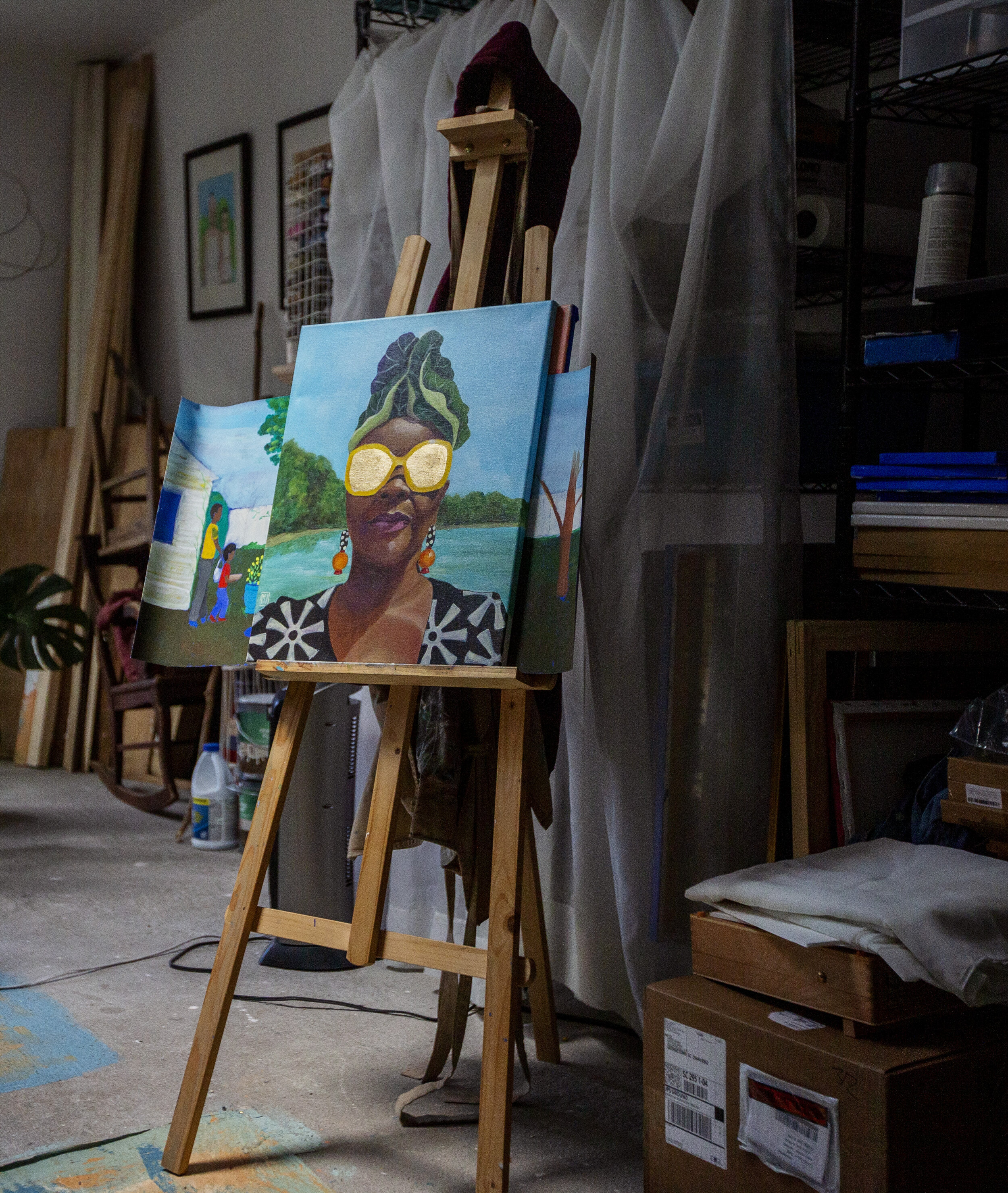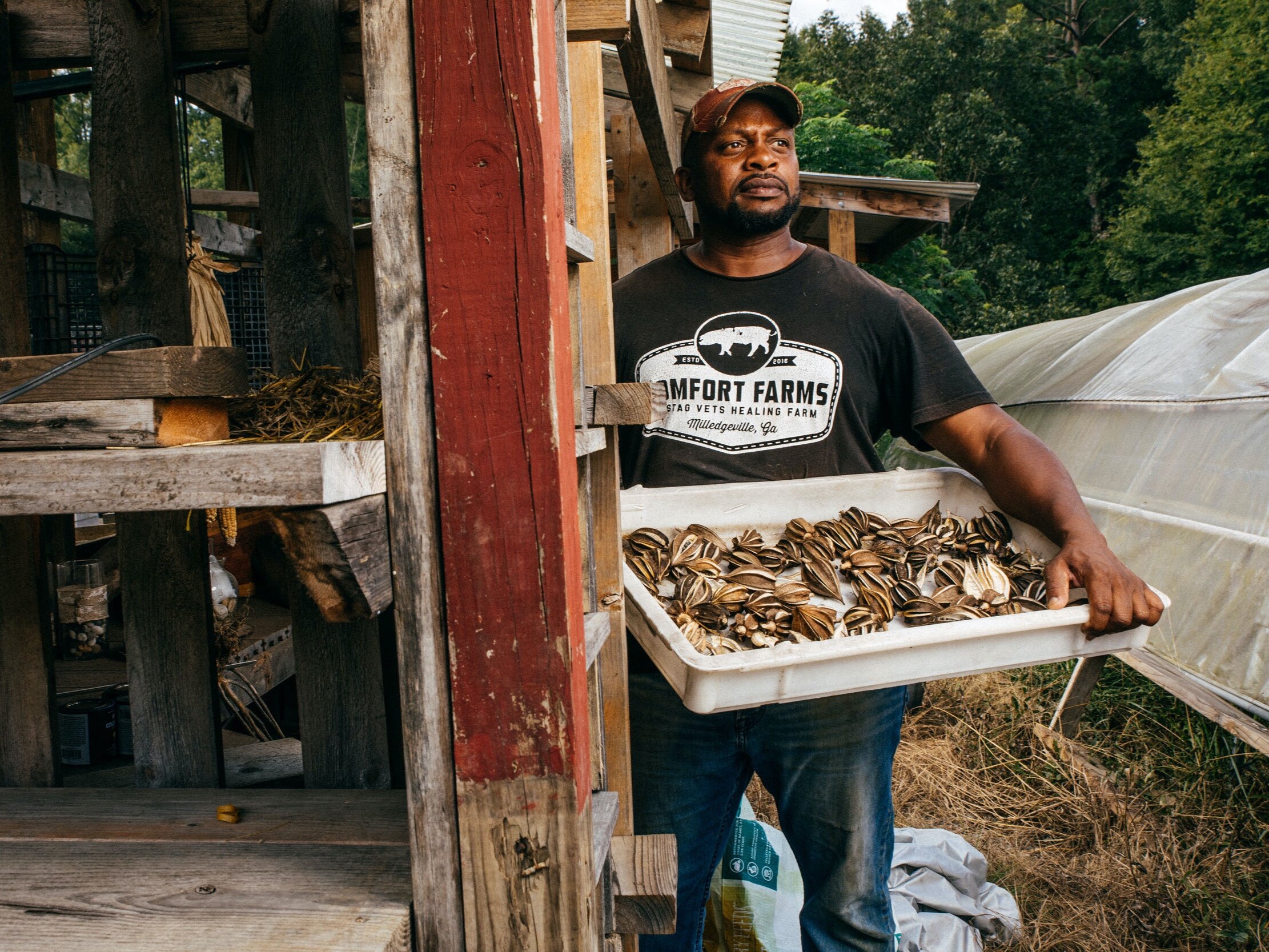The artist Natalie Daise invited Stephanie Burt, host of “The Southern Fork” podcast, to visit her studio in Georgetown, South Carolina. What began as a conversation about painting — exploring the beauty of black, gold, rice, and collard greens — evolved into a deeper conversation about safety, violence, and creative power. We invite you to look, listen, and enter Daise’s room where she explores materials, memory, and the “lived life.” Put on your headphones, open your eyes, and take off your shoes; you are standing on holy ground.
Conversation & Audio by Stephanie Burt
Photographs by Gavin McIntyre
~ Listen along as Daise talks with Burt about her studio and art featured below. ~
I use whatever tools I have at my disposal to create a safe place for myself. The studio. My work. My work creates a safe place for me. — Natalie Daise
The road to Natalie Daise’s home and studio is a turn off the main road onto a narrow lane through straight pine trees in Georgetown County, away from the familiar and fast and got-to-get-somewhere divided highway. Instead, the well-worn asphalt heads to a different destination, one of invitation to detour, to visit, to commune.
Natalie Daise’s voice and face are familiar to many who grew up in the 1990s. She and her husband, Ron Daise, starred in Nickelodeon's “Gullah Gullah Island,” a television show that ran from 1994–1998 and became one of the most popular shows for children during the era. It was developed for preschoolers, with puppets and music, and it depicted an African American family and other children on an imagined Sea Island. After the cameras turned off, the Daise family returned to full-time life in the South Carolina Lowcountry, and Natalie Daise began tapping into an innate love for drawing and painting, exploring storytelling through brushes, paint, surface, and craft. Images of strong women began to emerge, images of African symbols, pain and praise, family, and the sacred in the everyday. She earned her master’s in creative studies from Union Institute and University in 2014, and her works span mediums, from school presentations and a one-woman show performance titled “Becoming Harriet Tubman,” to visual arts shows, including as a competition artist at Artfields in 2016, and solo shows at the North Charleston Coliseum and the McClellanville Arts Center. Daise’s solo art exhibition at (CAVA) Cherokee Alliance of Visual Artists in Gaffney, South Carolina, that was scheduled for January and February 2021, is on hold due to COVID-19.
A selection of Daise’s work with excerpts from her conversation on Black womanhood, West African symbology, the beauty of hands, delight in everyday life, and the search for safety:
Free Your Mind Remix
This was an exploration. I have a friend who said to me once, “Art was a problem I could solve.”
I’m an Explorer of material, and there are ideas and things bubbling up in my head. And sometimes the idea is driven by the material. Sometimes the idea is driven by something I've seen. Sometimes it's just something that's evolved. Sometimes it's words, sometimes it's a feeling.
She Rises I
She Rises II
I had been talking to my daughter who was at the time a student at the College of Charleston. And we were talking about, you know, “It's hard for me to go to the club,” she said, “'cause, you know, if you're conscious at all, you're dancing to music that's about like raping you, and how can you do that?” And so I started creating this piece and I wanted to do something that was about her sacredness, the sacredness of her Black womanhood.
St Tendaji
West African Gold
Adinkra symbols are from Ghana … They’re West African religious icons and each symbol has its own meaning, for example, in this piece here, that is a symbol for strength and endurance [Hye Won Hye “that which does not burn”] that’s worked into the background behind his head [and into her dress].
By Hand, eggs
By Hand, Watering
There's a line from Langston Hughes, that circles each one of them: “I found that my own hands can make the world that's in my mind.” That act of living your life that my daughter calls “the lived life” is a sacred and holy thing. In my visual art, I want to elevate the story of Us, to show that, not to make it sacred. It is. To acknowledge its holiness, its sacredness, its beauty, that that act of just her holding that hose and had her thumb on, to make this spray, that was a wonderfully sacred and beautiful thing.
Hands are wonderful. They will tell as much as a face and there's all kinds of motion in them. I mean, they're beautiful things, you know, I look at mine and, you know, they're working hands and I love that. You know, they're not pretty and soft and smooth. They're rough and they're large. And lately, I've started doing my nails and that was just been a little ritual … of, “I am going to do this thing that is about nothing but beauty for its own sake, even though I'm going to go in the studio and they're going to get messed up, they aren't going to last, but then I'll do it again.”
India in a Collard Crown
When I think of collard greens, I think of my father and the greens were family, and the greens were community and they were like every Black Southern family I know who has a gathering. Somebody's bringing greens. And I began to think how daddy grew them, and he cooked them and my mama cooked them. And now I cook them. And whenever there's a family gathering that was large — in the pre-COVID days — I cooked the greens. It was known that “Natalie's going to bring the greens.” There's this lineage of greens that became the heritage and story and gathering.
They became that lineage, and they began to morph into more than just greens in a painting. I would do portraits of greens. I'd call it like, you know, “the green close-up” because they're beautiful … you can see violet in their leaves and you can see there's just so much in the light shining on them and the edge of them. And so, you know, I'm the person who you might see in your backyard. Like. “Why is that chick taking pictures of my greens in my backyard?”
Sara with a SweetGrass earring
Collard Queen
When I did the “Collard Queen,” I had my daughter, who's been a muse, pose with greens. … And then one day, I said, “Oh, she's dressed in them.” And I painted a full length nude. I see this wonderful sculpture of the strong woman and I paint a full-length nude. And then I dressed her green by green, by green. So if you were able in that painting to remove the greens, you would see a full-length body underneath, completely painted. And then I sculpted the dress around her and it took me in a whole different direction.
Self Portrait with Collards
You do what you can. I journal every day, pretty much. And I use whatever tools I have at my disposal to create a safe place for myself. The studio. My work. My work creates a safe place for me.
My grandmother was a very positive influence in my life. And she always was like, “Well, just count your blessings. Start at ‘A’ and go to ‘Z.’” And sometimes that’s what I’m doing in my journal. A. Air! I can be grateful for that; I can remember that right now. Uh, B. I had a banana for breakfast! You know.
And so, if we talk about how talking to someone helps you understand what you do, I am understanding, as I speak to you, that my art creates a safe place for me.
Stephanie Burt is the host of “The Southern Fork” podcast and a writer based in Charleston, South Carolina. Her work has appeared in numerous publications, including Saveur, The Washington Post, CNN's Parts Unknown, Conde Nast Traveler, and the Southern Foodways Alliance's Gravy. She focuses on researching heirloom ingredients, interviewing passionate culinary makers, and, when she's in the kitchen, perfecting her roasted chicken recipe.
Gavin McIntyre is a photographer located in Charleston, South Carolina, who documents the everyday life of people in his community. You can find more of his work at gavinmcintyre.squarespace.com.



















